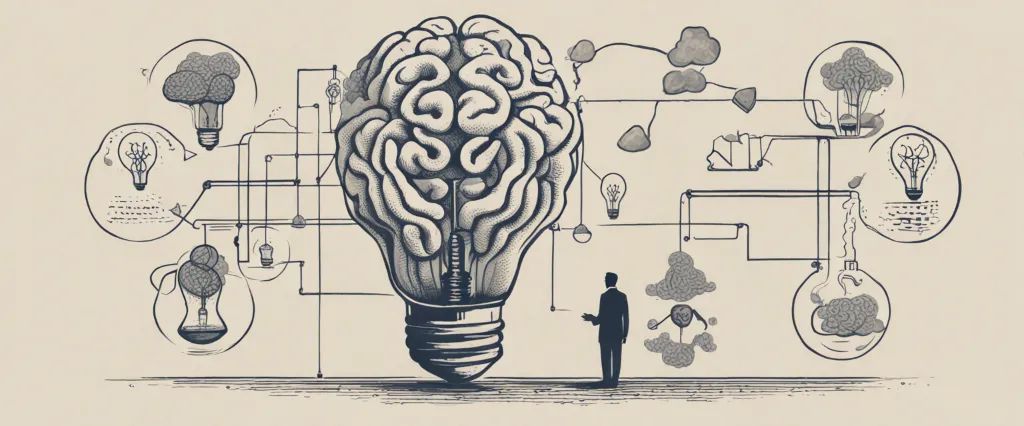In “The Innovator’s DNA,” Jeffrey H. Dyer explores the characteristics and strategies that distinguish innovative entrepreneurs and leaders from their counterparts. Through extensive research, Dyer and his co-authors bring to light five behavioral skills that foster innovation and provide a framework for individuals and organizations to nurture their innovative potential. As a recognized expert on innovation and a professor of strategy at Brigham Young University’s Marriott School of Business, Jeffrey H. Dyer has extensively studied how executives and entrepreneurs successfully drive innovation in their organizations. His research has been published in leading academic journals, making him a highly regarded authority in the field of innovation.
Chapter 1: Traits and Behaviors of Innovators
Chapter 1 of “The Innovator’s DNA” by Jeffrey H. Dyer examines the various traits and behaviors that separate innovators from non-innovators. The chapter begins by introducing the concept that innovation is not purely a genetic inheritance but can be learned and nurtured through specific practices and habits.
The first trait discussed is associating: the ability to connect seemingly unrelated ideas, concepts, or experiences to generate novel solutions. Innovators excel at pattern recognition and are constantly seeking new perspectives and insights. They cultivate a diverse network that exposes them to different industries, cultures, and disciplines, allowing them to make unique associations.
The second trait explored is questioning. Innovators constantly challenge the status quo by asking probing questions and being curious about every aspect of their work. They are driven by a relentless desire to understand why things work the way they do, and they follow these questions wherever they may lead. By challenging conventional wisdom, they uncover hidden opportunities for innovation.
Next, the author discusses the trait of observing. Innovators actively observe the world around them, paying attention to the smallest details, and continuously seeking to understand customer needs and pain points. This keen sense of observation allows them to identify unmet needs and identify areas where innovation can make a difference.
The chapter then delves into networking as a trait of innovators. Innovators build and maintain a diverse network of individuals who come from different backgrounds, industries, and perspectives. They leverage these relationships to gain insights and access to new ideas and opportunities.
Lastly, the chapter emphasizes experimenting as a critical behavior of innovators. Innovators are not afraid to take risks and try new approaches. They use experiments as a way to test and refine their ideas, learn from failure, and iterate towards success.
In summary, Chapter 1 of “The Innovator’s DNA” examines the traits and behaviors of innovators, including associating, questioning, observing, networking, and experimenting. These traits can be nurtured and developed, allowing individuals to cultivate an innovative mindset and become agents of change in their fields.
Chapter 2: Ability to Spot Opportunities
Chapter 2 of “The Innovator’s DNA” by Jeffrey H. Dyer explores the key concept of the ability to spot opportunities as a crucial component of innovative thinking. The chapter delves into the characteristics and behaviors required to identify and seize these opportunities, illustrating the importance of cultivating this skill in aspiring innovators.
Dyer introduces the concept of “associational thinking,” which involves making connections across seemingly unrelated domains. He explains that innovators have a knack for spotting patterns and relationships that others miss, allowing them to generate unique ideas. They actively seek out diverse experiences, often immersing themselves in different cultures, industries, or disciplines, which expands their mental frameworks and facilitates connecting unexpected dots.
The author also emphasizes the significance of cognitive empathy, which involves understanding and appreciating the needs and preferences of others. Innovators excel at empathizing with customers or potential users, enabling them to spot opportunities for improvement or novel solutions to unaddressed problems. By putting themselves in the shoes of others, these innovators can identify gaps in existing products or services, driving their creative endeavors.
Furthermore, Dyer explores the value of questioning established norms or assumptions. Innovators possess a curiosity that motivates them to challenge the status quo and explore alternative possibilities. They continuously ask “Why?” and “What if?” to uncover fresh perspectives and untapped opportunities.
In this chapter, Dyer provides numerous examples from successful innovators like Howard Schultz of Starbucks and Reed Hastings of Netflix, illustrating how their ability to spot opportunities fueled their groundbreaking ideas. Ultimately, the chapter highlights that spotting opportunities is a fundamental skill for innovators and can be developed through efforts in diverse experiences, cognitive empathy, and questioning conventional wisdom.
Chapter 3: Observation-Based Insight
Chapter 3 of “The Innovator’s DNA” by Jeffrey H. Dyer is titled “Observation-Based Insight.” This chapter delves into the importance of observing and gaining insight from the world around us as a key component of innovative thinking.
The chapter begins by highlighting the importance of curiosity and how it can enhance our ability to observe and seek out new knowledge and ideas. Innovators are constantly curious, always looking for new information and making connections between seemingly unrelated areas. They never settle for the status quo and actively seek out opportunities for learning and growth.
Dyer then emphasizes the power of observational skills, which help innovators identify unique and groundbreaking insights. Innovators are keen observers, paying attention to the details and patterns in their surroundings. They use all their senses to take in their environment and capture new ideas, often combining different pieces of information to generate novel insights.
The author also addresses the concept of “mind wandering,” which refers to the deliberate detachment from immediate tasks to allow the mind to freely explore new ideas and possibilities. Innovators actively practice mind wandering as it helps them break away from conventional thinking and encourages the generation of fresh perspectives and associations.
Additionally, Dyer highlights how innovators use different perspectives and lenses to observe the world. They actively seek out diverse experiences, interact with people from different backgrounds, and immerse themselves in new environments. This exposure to varied perspectives helps them challenge assumptions, break mental models, and discover new solutions.
In summary, Chapter 3 emphasizes the critical role of observation-based insight in cultivating innovative thinking. Innovators are curious, observant, and constantly seek new knowledge. They allow their minds to wander and explore, embracing diverse perspectives to generate groundbreaking insights.
Chapter 4: Connecting Dots

Chapter 4 of “The Innovator’s DNA” by Jeffrey H. Dyer focuses on the skill of connecting dots, which is an essential characteristic of innovative thinkers. The chapter delves into the concept of associating different ideas and experiences in order to generate new insights and breakthrough innovations.
The chapter begins by emphasizing the importance of being curious and actively seeking out new knowledge. It argues that innovative individuals are constantly exploring diverse sources of information, such as books, articles, and conversations, to gather a wide range of ideas. They are eager to learn from unrelated fields and challenge traditional assumptions.
Furthermore, the chapter highlights the significance of engaging in different contexts and experiences. Innovators venture outside of their comfort zones and expose themselves to diverse environments, cultures, and industries. This exposure allows them to connect seemingly unrelated dots and draw inspiration from a variety of sources.
The author provides several examples of individuals who have successfully connected dots to drive innovation. For instance, Steve Jobs famously linked his calligraphy course to the design of Apple’s Macintosh computer, which ultimately revolutionized the industry. Similarly, Gatorade, the iconic sports drink, was created by scientists who connected their research on electrolyte loss in kidneys to the needs of athletes.
The chapter also explores various strategies to enhance one’s ability to connect dots. It suggests techniques such as mind mapping, brainstorming, and engaging in interdisciplinary collaborations. Furthermore, it underscores the importance of observing customer behaviors, identifying patterns, and synthesizing information to connect dots effectively.
In conclusion, Chapter 4 of “The Innovator’s DNA” emphasizes the importance of the connecting dots skill in driving innovation. It showcases the value of curiosity, exposure to diverse experiences, and active engagement with different fields of knowledge. By intentionally seeking out new connections, innovators are able to generate groundbreaking ideas and establish themselves as thought leaders in their respective industries.
Chapter 5: Culture of Experimentation and Learning
Chapter 5 of “The Innovator’s DNA” by Jeffrey H. Dyer focuses on the importance of creating a culture of experimentation and continuous learning within an organization in order to foster innovation. The chapter explores the different elements that contribute to such a culture and offers practical suggestions for leaders to implement.
The chapter begins by emphasizing the need for leaders to not only encourage experimentation but also to actively participate in it themselves. Leaders who are willing to take risks and learn from failures set an example for their teams and create an environment that encourages innovative thinking. In addition, the chapter highlights the importance of allocating resources for experimentation, providing employees with the necessary time, funds, and space to explore new ideas.
Dyer suggests that organizations should embrace the concept of “intelligent failure,” where failures are viewed as opportunities for learning and growth. This involves creating a safe space for employees to take risks, learn from their mistakes, and iterate their ideas. Furthermore, the chapter stresses the significance of sharing knowledge and insights gained from experiments across the organization, allowing others to build on previous findings.
To foster a culture of experimentation and learning, the chapter suggests implementing systems and processes that support innovation. This includes establishing clear metrics and goals, creating cross-functional teams, and promoting collaboration and diversity of thought. By involving diverse perspectives and providing opportunities for cross-functional interaction, leaders can stimulate creativity and generate new ideas.
In conclusion, Chapter 5 of “The Innovator’s DNA” emphasizes the importance of creating a culture of experimentation and continuous learning within organizations. It suggests that leaders play a crucial role in fostering such a culture by actively participating in experimentation, promoting intelligent failure, sharing knowledge, and implementing systems and processes that support innovation. By doing so, organizations can cultivate an environment that encourages creativity, risk-taking, and ultimately, innovation.
Chapter 6: Cross-Boundary Collaboration and Partnerships
Chapter 6 of “The Innovator’s DNA” by Jeffrey H. Dyer, focused on the importance of cross-boundary collaboration and partnerships in fostering innovation.
The chapter begins by emphasizing that innovation often occurs at the intersection of different disciplines or industries. It highlights the famous example of the collaboration between Steve Jobs (Apple) and Steve Wozniak (co-founder of Apple), who combined their expertise in technology and design to create groundbreaking products. The chapter argues that partnerships between people with diverse backgrounds, knowledge, and skill sets can lead to breakthrough innovations.
Next, the chapter introduces the concept of “T-Shaped” individuals, who possess deep expertise in one field (the vertical stroke of the T) and also have the ability to collaborate across multiple disciplines (the horizontal stroke of the T). These T-shaped individuals can bridge gaps and connect ideas from different domains, enhancing innovation.
The chapter also explains the importance of creating a culture of collaboration within organizations. It suggests that leaders need to encourage employees to share knowledge, ideas, and resources across departments, breaking down silos. Additionally, it highlights the significance of external collaborations, such as partnerships with suppliers, customers, universities, or other organizations. These external collaborations can bring fresh perspectives, new capabilities, and access to resources not readily available within the organization.
The chapter concludes by providing practical strategies for fostering cross-boundary collaboration and partnerships. It suggests creating diverse teams, facilitating knowledge sharing and networking, organizing cross-functional projects, and seeking out external partners that can offer complementary expertise and resources.
In summary, Chapter 6 of “The Innovator’s DNA” emphasizes the value of cross-boundary collaboration and partnerships in driving innovation. It emphasizes the need for T-shaped individuals, a culture of collaboration within organizations, and strategic external collaborations to merge different perspectives, expertise, and resources for innovative results.
Chapter 7: Agile Decision Making and Execution
Chapter 7 of “The Innovator’s DNA” by Jeffrey H. Dyer delves into the concept of agile decision making and execution. It emphasizes the importance of flexibility, adaptability, and nimbleness in today’s fast-paced and unpredictable business environment.
The chapter begins by asserting that innovators are not afraid of making mistakes and taking risks. They view failures as learning opportunities and understand the value of quick decision-making based on imperfect information. This agility enables them to outperform competitors and adapt to changing market conditions.
To develop agile decision-making skills, the author introduces the “burndown technique.” This technique involves breaking down large complex projects into smaller milestones that can be completed in short timeframes. It focuses on progress tracking and continuous evaluation, allowing innovators to quickly adjust their strategies based on real-time feedback. The burndown technique also promotes transparency and collaboration within teams, enhancing overall organizational agility.
Furthermore, the chapter highlights the importance of building a culture that embraces experimentation and learning. Innovators encourage their employees to challenge the status quo, propose new ideas, and seek feedback from diverse sources. Such a culture fosters creativity, resilience, and adaptability, leading to improved decision making and execution.
The author concludes by emphasizing the ongoing nature of agile decision making and execution. He encourages readers to continually refine their processes, learn from both successes and failures, and stay vigilant in embracing change. By doing so, individuals and organizations can develop a competitive advantage in a rapidly evolving business landscape.
Overall, Chapter 7 of “The Innovator’s DNA” emphasizes the significance of agile decision making and execution as key drivers of innovation and success in today’s dynamic business environment.

Chapter 8: Sustained Innovation and Growth
Chapter 8 of The Innovator’s DNA by Jeffrey H. Dyer focuses on sustained innovation and growth. Dyer emphasizes that innovation is not a one-time event but a continuous process that requires ongoing effort and dedication from individuals and organizations.
The chapter begins by emphasizing the importance of a growth mindset, which involves actively seeking out new ideas and opportunities for improvement. Successful innovators are not satisfied with the status quo; they constantly push boundaries and look for ways to evolve and adapt.
Dyer introduces the concept of “patient innovation,” which refers to the ability to maintain perseverance and commitment to innovation over the long term. He highlights the story of principles-driven companies like Procter & Gamble and 3M, which have been able to sustain innovation by fostering a culture that encourages exploration, experimentation, and risk-taking.
The author also discusses the “innovation premium” and how it relates to sustained growth. The innovation premium refers to the difference between a company’s market value and the value its assets would have if they were sold off today. Firms with a higher innovation premium are more likely to achieve sustained growth and long-term success.
To foster sustained innovation, Dyer provides several strategies that individuals and organizations can implement. These include encouraging interdisciplinary collaboration, creating an environment that supports innovative thinking, and building a diverse team that brings together different perspectives and expertise.
Overall, Chapter 8 of The Innovator’s DNA highlights the importance of sustained innovation and growth. By embracing a growth mindset, adopting patient innovation, and implementing strategies to foster innovation, individuals and organizations can continuously generate new ideas, adapt to changes, and thrive in today’s dynamic business environment.
After Reading
In conclusion, The Innovator’s DNA by Jeffrey H. Dyer explores the critical aspects of innovative thinking and provides valuable insights into developing and enhancing one’s own innovator’s mindset. The book emphasizes that innovation is not a rare talent but a capability that can be learned and nurtured through cultivating specific behaviors and habits. The authors present extensive research and real-life examples to support their argument and outline the five discovery skills that successful innovators possess. These skills include associating, questioning, observing, networking, and experimenting. Dyer also emphasizes the importance of gathering diverse inputs and being open to new ideas. Overall, The Innovator’s DNA serves as a guide to unlocking one’s potential for innovation and encourages readers to adopt and cultivate the mindset of an innovator in their personal and professional lives.
1. “Creative Confidence: Unleashing the Creative Potential Within Us All” by Tom Kelley and David Kelley – This book explores how individuals can cultivate their creative abilities and embrace innovation in all aspects of life, whether it be in business, personal pursuits, or social causes.
2. Originals: How Non-Conformists Move the World” by Adam Grant – Grant offers insights into the mindset and strategies of highly successful innovators and entrepreneurs. He examines how they challenge the status quo, navigate risks, and foster original ideas in order to make a meaningful impact.
3. The Lean Startup: How Today’s Entrepreneurs Use Continuous Innovation to Create Radically Successful Businesses” by Eric Ries – Ries outlines a systematic approach to launching and managing startups based on continuous innovation. He presents practical methods for quickly testing ideas, pivoting when necessary, and building successful businesses with limited resources.
4. The Innovator’s Dilemma: When New Technologies Cause Great Firms to Fail” by Clayton M. Christensen – This classic book explores the concept of disruptive innovation and its impact on established companies. Christensen provides compelling case studies and offers valuable insights on how companies can avoid becoming irrelevant in the face of technological advancements.
5. “Design Thinking: Integrating Innovation, Customer Experience, and Brand Value” by Thomas Lockwood and Edgar Papke – Exploring the practical aspects of design thinking, this book highlights how organizations can leverage user-centric approaches to drive innovation and create exceptional customer experiences. Through case studies and practical tips, the authors guide readers in applying design thinking principles to their own work.




